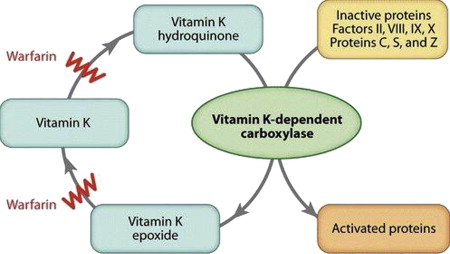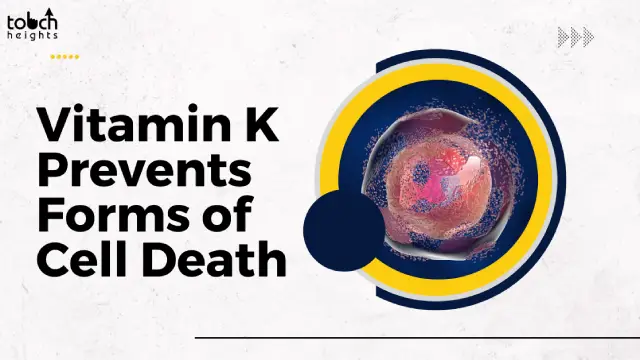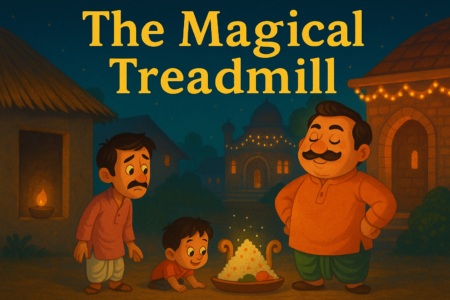Although vitamin K is well recognized for helping blood clot and promoting bone growth, a recent study published in Nature describes the vitamin’s involvement in a brand-new process.
The blood clotting protein functions as an antioxidant, effectively preventing ferroptosis cell death, and vitamin K in its fully concentrated form.
Ferroptosis, a kind of spontaneous cell death that is also characterized by the oxidative disintegration of cellular membranes, is a process that occurs when cells die naturally. Cellular iron is a key component of this process. The researchers also discovered that the long-suspected but unexplained warfarin-insensitive enzyme reducing vitamin K is called FSP1.

The scientists found that vitamin K in its completely reduced form functions as an antioxidant by effectively preventing ferroptosis cell death. Ferroptosis, a kind of spontaneous cell death that is likewise characterized by the oxidative disintegration of cellular membranes, is a process in which cellular iron plays a crucial role.
The researchers also discovered that the long-suspected but unexplained warfarin-insensitive enzyme reducing vitamin K is called FSP1. Ferroptosis has been associated with several disorders in recent years, including Alzheimer’s disease and sudden organ damage. The available findings, therefore, support the idea that vitamin K therapy might be a novel and successful treatment for a variety of ferroptosis-related conditions.
Vitamin K is a potent ferroptosis suppressor

Research into new mechanisms and chemicals that govern ferroptosis is continuing since it is thought that inhibiting ferroptosis is a very promising approach for treating many degenerative diseases. Under the guidance of Drs. Eikan Mishima and Marcus Conrad, both from the Institute of Metabolism and Cell Death at Helmholtz Munich, scientists from Tohoku University (Japan), the University of Ottawa (Canada), and the Technical University of Dresden (Germany), identified these novel compounds by carefully examining a number of naturally occurring vitamins and their derivatives. Dr. Eikan Mishima, the lead author of the study, said, “Surprisingly, we found that vitamin K, which is composed of phylloquinone (vitamin K1) and menaquinone-4 (vitamin K2), may effectively prevent cells and tissues from going through ferroptosis.
Uncovering the long-sought vitamin K-reducing enzyme FSP1

A research team led by Dr. Marcus Conrad identified ferroptosis suppressor protein-1 (also known as FSP1) as a fresh and powerful regulator of ferroptosis in 2019. The research group has shown that reduced vitamin K hydroquinone performs as a strong lipophilic antioxidant and prevents ferroptosis by snatching oxygen radicals in lipid bilayers.
They also found that FSP1 is the enzyme that efficiently converts vitamin K to vitamin K hydroquinone, causing the activation of a fresh, unorthodox vitamin K cycle. Given that vitamin K is essential for blood clotting processes and is one of the most often prescribed anticoagulants, the researchers went on to show that FSP1 is the reason the vitamin K-reduction pathway is insensitive to warfarin.
Breakthrough in understanding vitamin K metabolism

By finding this enzyme, the last puzzle about the role of vitamin K metabolism in blood clotting was cleared up, and it was also made clear how vitamin K works as an antidote for warfarin overdose. Thus, the two fields of ferroptosis research and vitamin K biology are connected by our findings.
They will serve as a catalyst for the development of novel therapeutic strategies for disorders for which ferroptosis has been implicated, “The point was made by Dr. Marcus Conrad. Because ferroptosis is most likely one of the earliest kinds of cell death, the researchers also speculate that vitamin K may be one of the first forms of naturally occurring antioxidants. Dr. Marcus Conrad predicts that vitamin K’s role in the creation of life will thereby take on new dimensions.
Summary
Vitamin K is available in two major forms: K-1 and K-2.
The primary dietary source of vitamin K is K-1, which is predominantly found in leafy green vegetables. However, K-2 is more easily absorbed by the body, especially the K-2 variant MK-7.
Organ meats, dairy products, and fermented foods are all excellent sources of vitamin K-2. Natto is a very potent example of a fermented soybean food that is high in vitamin K-2. Small amounts of K-2 are also produced by gut bacteria in humans.
Both types of vitamin K are necessary for healthy bone development and blood clotting. Vitamin K-2, however, may also offer protection against several types of cancer and heart disease.
The majority of individuals consume adequate vitamin K in their diets, making vitamin K deficiency quite unusual. The possibility of a deficit might be exacerbated by several gastrointestinal illnesses. Before using a dietary supplement, anyone with certain disorders should see their doctor.
Without first seeing a doctor, those who are presently using blood thinners like warfarin shouldn’t use vitamin K supplements. Warfarin’s anticoagulant actions can be adversely affected by abrupt fluctuations in vitamin K levels, which can result in life-threatening consequences.







